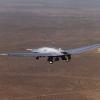Lockheed Martin, Boeing, and the Defense Advanced Research Projects Agency (DARPA) developed the stealthy, low-observable DarkStar to provide sustained reconnaissance information from anywhere within enemy territory, day or night, in all types of weather. Developed concurrently with the nonstealthy RQ-4A Global Hawk, DarkStar could provide near real-time target data and imagery by way of satellite links to its mobile ground station.
The first DarkStar prototype flew successfully in March 1996 but crashed during its second flight a month later. More than two years passed before a second prototype took to the air and performed an autonomous takeoff, flight plan, and landing. It made five flights before the program was canceled in January 1999. The DarkStar displayed here was built before the program ended but never performed a flight test. When the Museum acquired it, the inlet and the exhaust had been sealed due to the classified nature of the design.
Display Status
This object is not on display at the National Air and Space Museum. It is either on loan or in storage.
Object Details
Date
1996
Country of Origin
United States of America
Type
CRAFT-Aircraft
Physical Description
High altitude, strategic reconnaissance platform designed with a "stealthy" radar signature. Perhaps the strangest UAV in the collection resembling a flying saucer with long, narrow wings.
Dimensions
3-D: 457.2 × 106.7cm, 1769kg, 21.031m (15 ft. × 3 ft. 6 in., 3900lb., 69 ft.)
Materials
Aluminum, carbon fiber, steel, glass, copper, plastic, rubber, paint
Inventory Number
A20070230000
Credit Line
Transferred from the National Museum of the United States Air Force
Data Source
National Air and Space Museum
Restrictions & Rights
Usage conditions apply
For more information, visit the Smithsonians Terms of Use.


